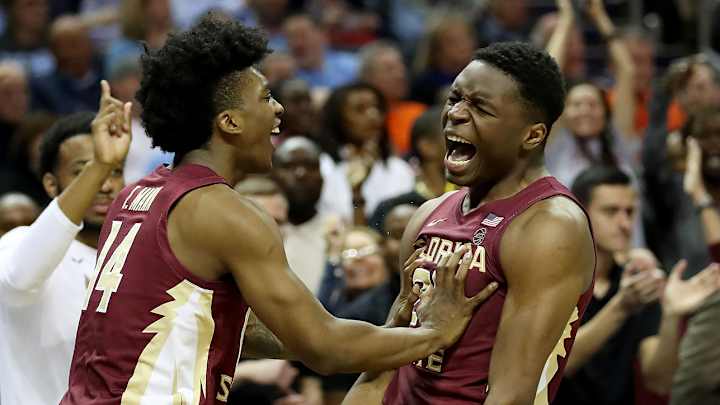March Madness Sleeper Watch: Lower Seeds That Could Crash the Final Four

Never worry about busted brackets again! Sign up to play SI’s Realtime Bracket game. If your original pick is losing, you can switch it during live tournament games. Game leaderboards track original AND realtime picks.
Just one team below a No. 3 seed has won the NCAA tournament since 1997, the year fourth-seeded Arizona won the program’s lone national title. Over the ensuing two decades, every national champion but one has come from the nation’s top 12 teams as ranked by the selection committee, with the lone exception being Shabazz Napier and UConn’s 2014 title run from the No. 7 seed.
The Final Four field, however, is much more prone to parity. A team seeded below the No. 3 line has survived the second weekend of the tournament in nine-straight years. The Huskies swiped the trophy in 2014, while Loyola-Chicago, South Carolina and Syracuse each won their regions in the last three seasons. If history is any indicator, the 2019 NCAA tournament will likely see another darkhorse win one of the four regions and move on to Minneapolis.
You’ve heard plenty about this year’s championship favorites. Which teams could pull an upset and storm their way to the Final Four? We chose five likely candidates to stay alive until April.
Florida State (No. 4, West Region)
The Seminoles fell just short of the Final Four in 2018, losing to Michigan 58–54 in the West Regional final. They enter the 2019 tournament as perhaps the best sleeper bet to make it to Minneapolis. Leonard Hamilton’s squad won six straight before running into the Zion Williamson–led Duke buzzsaw in the ACC tournament final, but not before wins over Virginia and Virginia Tech. Florida State beat LSU and Purdue in November, then Louisville and Syracuse in February. Their résumé backs up a top-four seed.
Florida State has enough wingspan to make Jay Bilas weep, starting with 7'4" center Christ Koumadje. Sophomore sixth man Mfiondu Kabengele leads kenpom.com’s No. 9 defense and paces the Seminoles in scoring. Florida State may have to bruise its way past Gonzaga in the Sweet 16. One of the nation’s two top scorers, Murray State’s Ja Morant or Marquette’s Markus Howard, will be waiting in the second round if the Seminoles can handle Vermont and leading scorer Anthony Lamb on Thursday. A tough draw could derail Florida State in the West Region, but the school’s first Final Four appearance is as likely as any team seeded fourth or lower. The Seminoles are tough, tested and ripe for another long run.
Iowa State (No. 6, Midwest)
The Cyclones will have to shoot their way to the Final Four. They’re kenpom’s No. 9 offense and run six deep with scoring options. Virginia transfer Marial Shayok leads the way with 18.6 points per game, while Talen Horton-Tucker, Michael Jacobson and Lindell Wigginton all average in double figures. Iowa State blew past Kansas to win the Big 12 tournament after beating regular season co-champ Kansas State the day before, but its most impressive win of the season came on Jan. 16 when the Cyclones beat the other co-champ Texas Tech 68–64 in Lubbock. Midwest No. 3 seed Houston will likely be in for a rough round-two battle.
Iowa State would truly have to get hot for a Final Four run, with Kentucky potentially waiting in the Sweet 16 and North Carolina atop the Midwest Region. The Cyclones are armed for a shootout, though, and could ride a three-point wave all the way to Minneapolis.
Villanova (No. 6, South)
Jay Wright leading this Villanova team to the Final Four would perhaps be an accomplishment on par with the Wildcats’ 2016 or ’18 national championships. The 2016 crew won five-straight tournament games by double digits, including a 44-point beatdown of Oklahoma in the Final Four, to set up Kris Jenkins’s legendary buzzer beater. Last year’s squad was a No. 1 seed with one of the deepest and deadliest offenses in the country.
This year’s group of Wildcats is less imposing, ranking 123rd in points per game this season. Guard Phil Booth and forward Eric Paschall remain as senior leaders, but there is a lack of proven firepower behind them. Still, never count out the defending champions, and the bracket isn’t completely unfavorable, as the South Region doesn’t possess an offensive powerhouse like Kentucky or North Carolina. It’s not hard to envision Booth grinding out tight wins against Tennessee or Virginia. If so, perhaps more March magic is in store for the Wildcats and Wright, the tournament’s sartorial star.
Cincinnati (No. 7, South)
If you think the South is ripe for a dash of chaos, the seventh-seeded Bearcats could be a good bet for the school’s first Final Four since the Nick Van Exel–led team’s run in 1992. Mick Cronin’s crew allows just 62.2 points per game and held Houston to 57 in the AAC championship. Tennessee could be in for a rock fight in the second round. Rick Barnes lost in the first weekend 11 times with Texas. A second first weekend exit with Tennessee would be his most painful of all. The Volunteers should be on upset alert on Sunday. The Bearcats will be a difficult out.
Nevada (No. 7, West)
The Wolf Pack’s tournament résumé is a touch uninspiring: Their best win of the season at home against Utah State. Nevada lost three of its last eight games entering the tournament, including an ugly loss to San Diego State in the Mountain West tournament, but past performance isn’t necessarily indicative of future results.
Nevada is similar to Iowa State in its wealth of scorers, headlined by seniors Caleb Martin and Jordan Caroline; Caleb’s twin brother Cody Martin also averages double digits and improved from beyond the arc in 2018–19. The Wolf Pack are deep and senior-laden. We could be in for a mid-major battle between Gonzaga and Nevada in the West regional final. Nevada lost by one in the Sweet 16 last year, briefly stealing the tournament spotlight again under the direction of energetic coach Eric Musselman. They could advance past the second weekend in 2019.
Other Mid-Seeds Considered, but Ultimately Dismissed
Mississippi State (No. 5, East): Ben Howland’s Bulldogs have an argument as the third-best team in the East Region, but another injury to Williamson is the only thing that will derail Duke before the Elite Eight.
Kansas (No. 4, Midwest): Maybe the Jayhawks deserve some benefit of the doubt after three Final Fours in the Bill Self era. History aside, there’s not much to believe in. Kansas is limping into the tournament and is more than a step below higher Midwest Region seeds Kentucky and North Carolina. A round-one exit at the hands of Northeastern is in play.
Murray State (No. 12, West): Morant is the second-most exciting player in the tournament. He could be the second pick in the NBA draft, too. Marquette’s Markus Howard could defeat him in a first-round scoring duel, though, and potential second-round opponent Florida State is a true Final Four contender, as discussed above. The road to Minneapolis is just too tough.
